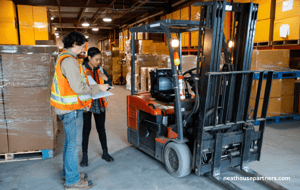Safeguarding Your Workplace: A Comprehensive Guide to Manual Handling
Manual handling is a critical aspect of workplace safety, yet in the UK it accounts for nearly a fifth of all workplace injuries.
James Rowland
Commercial Director James leads Account Management, Sales and Marketing at Neathouse Partners.Date
16 January 2024Updated
12 June 2024
Table of contents
Related articles
Tags
Manual handling is a critical aspect of workplace safety, yet it accounts for nearly a fifth of all workplace injuries.
The consequences of inadequate manual handling precautions can be severe, ranging from personal injuries and lost production to legal fines.
In this article, we'll delve into the intricacies of manual handling at work, exploring its definition, associated laws and crucial guidelines for both employers and employees.
What is Manual Handling?
Manual handling, as defined by the Health and Safety Executive (HSE), encompasses tasks involving the transportation or support of a load by hand or bodily force.
This includes lifting, lowering, pushing, pulling and any movement of a load without the use of equipment or machinery. A 'load' can be any movable object, human or animal.
Manual Handling and the Law

The legal obligations surrounding manual handling are primarily governed by two key pieces of legislation in the UK:
- The Health and Safety at Work Act 1974: This overarching legislation outlines employers' responsibilities towards their employees and the public in matters of health and safety.
- The Manual Handling Operations Regulations 1992: These regulations provide specific guidelines and rules for managing manual handling tasks in the workplace.
Key Responsibilities for Employers:
Under the Manual Handling Operations Regulations 1992, employers are obligated to:
- Avoid hazardous manual handling tasks where reasonably practicable.
- Assess the risks associated with unavoidable hazardous manual handling tasks.
- Take measures to reduce the risk of injury from hazardous manual handling tasks.
The concept of 'so far as is reasonably practicable' is central to these regulations, emphasising that employers must strive to eliminate risks in a practical and common-sense manner.
Employee Responsibilities:
Employees also bear responsibilities for safe manual handling, including:
- Adhering to established safe systems of work.
- Employing correct manual handling techniques when lifting objects.
- Using lifting equipment as intended.
- Acting in a manner that doesn't endanger themselves or others.
Deciphering 'Reasonably Practicable':
Determining what is 'reasonably practicable' can be challenging. Courts have clarified that employers must weigh the severity of risks against the necessary safety measures, always prioritizing health and safety.
Cost or inconvenience should not be the sole determinants; rather, the severity of the risk should guide decision-making.
Penalties for Breaches:
Breaching the Manual Handling Operations Regulations 1992 can lead to fines ranging from £5,000 to £20,000 in magistrates' court, with no legal limit in Crown Court for serious breaches. These fines apply to both employers and employees.
To avoid such penalties, it is crucial to ensure that employees receive proper training in manual handling techniques.
Most common Manual Handling Injuries - and how to avoid them

Manual handling injuries are unfortunately all too common in the workplace, constituting a significant portion of work-related injuries in the UK:
- A third of non-fatal injuries reported under RIDDOR 22/23 are due to a fall or slip on the same level, and
- 17% are due to handling, lifting or carrying.
The repercussions of these injuries extend beyond personal suffering to include lost productivity and potential legal consequences for employers.
-
Strains and Injuries
One of the most prevalent manual handling injuries is back strain or injury. Improper lifting techniques, overexertion and lifting loads beyond one's capacity contribute to these injuries.
Prevention Tips:
- Train employees on proper lifting techniques, emphasising the use of the legs and not the back.
- Encourage the use of lifting aids and equipment for heavy or awkward loads.
- Implement team lifting strategies for heavier items.
Musculoskeletal Disorders (MSDs)
MSDs affect the muscles, tendons, ligaments and other parts of the musculoskeletal system. Prolonged and repetitive manual handling tasks can lead to conditions like tendonitis and carpal tunnel syndrome.
According to the HSE's 22/23 figures, 473,000 workers in Great Britain are suffering from a work-related musculoskeletal disorder
Prevention Tips:
- Rotate employees through different tasks to avoid prolonged exposure to the same repetitive movements.
- Provide ergonomic tools and equipment to reduce strain.
- Encourage regular breaks to allow for rest and recovery.
Sprains and Strains
Strains and sprains can occur when muscles or ligaments are stretched or torn during manual handling activities.
Prevention Tips:
- Ensure that loads are within a manageable weight range for each employee.
- Implement a pre-task warm-up routine to prepare the body for manual handling activities.
- Promote a culture of reporting minor discomfort early to prevent the escalation of injuries.
Fractures and Crush Injuries
Heavy or awkward loads can lead to crushing injuries and fractures, especially if they are mishandled.
Prevention Tips:
- Clearly label the weight of loads and provide guidelines for safe handling.
- Use mechanical aids and equipment for lifting whenever possible.
- Ensure that employees wear appropriate personal protective equipment (PPE).
Falls and Trips
Manual handling activities often involve movement, increasing the risk of slips, trips and falls.
Prevention Tips:
- Keep work areas well-organised and free from obstacles.
- Provide non-slip footwear for employees involved in manual handling tasks.
- Ensure adequate lighting in work areas to reduce the risk of tripping.
Preventing manual handling injuries requires a combination of proper training, the use of appropriate equipment and fostering a safety-conscious culture in the workplace.
By addressing the root causes and implementing preventive measures, employers can significantly reduce the incidence of these injuries.
Investing in the health and safety of your workforce not only protects individuals but also contributes to a more productive and resilient work environment.
Get in touch with our friendly Health and Safety team by filling in this form to learn more about our popular fixed-fee H&S Package.
Related blog posts

The Importance of Workplace Ergonomics: Reducing the Risk of Musculoskeletal Injuries

Forklift Truck Workplace Safety

Safe Techniques For Carrying Heavy Or Bulky loads At Work
Have questions?
Get in touch today
Contact us, and our team will get back to you within 24 hours. We value your questions and are committed to getting them answered quickly.


Hello! I am Nicky
Just fill in the form below with your details, and I will arrange for a member of our team to give you a call.
By clicking, you agree to our Privacy Policy





